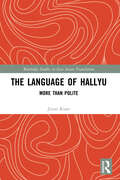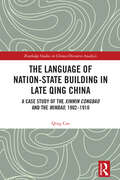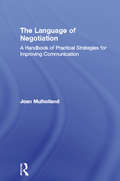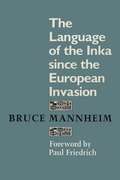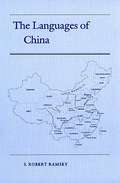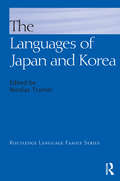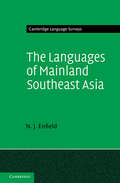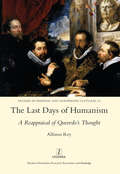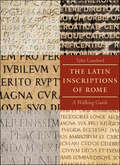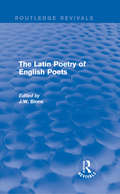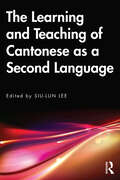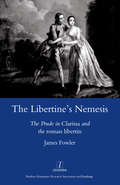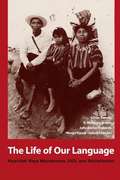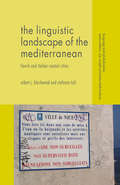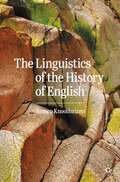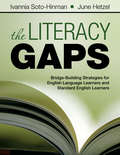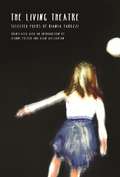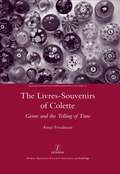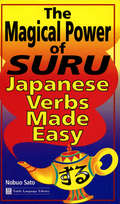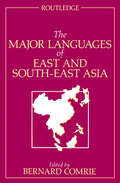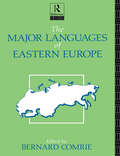- Table View
- List View
The Language of Hallyu: More than Polite
by Jieun KiaerThe Language of Hallyu will re-examine the language of the Korean Wave by looking at popular K-content. In doing so, it will expose the meanings that get lost in translation, hidden under subtitles. Over the past decade, hallyu (the Korean wave) has exploded in popularity around the globe. K-films, K-drama, and K-pop were once small subcultures, known mostly by Korea’s East and Southeast Asian neighbours and Korean diaspora. Now, K-content has entered the international mainstream. Consequently, interest in Korean language has grown, while interest in language learning in general has decreased. Many textbooks emphasise that Korean is a ‘polite’ language, but this book will highlight that this is not the case. The Language of Hallyu examines popular K-content, including Parasite (2019), Minari (2020), Squid Game (2021), and Pachinko (2022). The author introduces language stylistics to explain how Koreans style their language to suit every occasion. She argues that they do this via a process of visual scanning and social tuning, whereby visual clues are assessed in tangent with an individual’s sociocultural awareness. The author concludes by highlighting the danger of the jondaemal/banmal (polite/casual speech) divide, demonstrating that Korean language is so much more than polite. This book will be of interest to students and researchers in Korean language and culture, particularly those interested in linguistics and pragmatics.
The Language of Nation-State Building in Late Qing China: A Case Study of the Xinmin Congbao and the Minbao, 1902-1910 (Routledge Studies in Chinese Discourse Analysis)
by Qing CaoThe Language of Nation-State Building in Late Qing China investigates the linguistic and intellectual roots of China’s modern transformation by presenting a systematic study of the interplay between language innovation and socio-political upheavals in the final decade of the Qing Dynasty. This book examines the formations, internal tensions, and promotion of such macroconcepts as ‘nation people’ (guomin国民), nation (minzu民族), society (qun群), state (guojia国家) and revolution (gemin革命) as novel ideas borrowed from Europe but mediated through Meiji Japan. Using corpus-based discourse analysis of the full-text corpus (4.2 million words) of the two most influential periodicals Xinmin Congbao (新民丛报) and Minbao (民报), this book scrutinises the multi-faceted formulations of these concepts and their impact. It underscores the adaptation and appropriation of European post-enlightenment values to the socio-political conditions of late Qing society. The analysis centres on the epic debate (1905-07) between these two periodicals that offered two distinctive visions of future China. Comparable to the 18th century great debate between Edmund Burke and Thomas Paine on the French Revolution, the Chinese debate has hitherto attracted little scholarly attention outside China. Yet, the debate not only turned the tidal wave of the public opinion against the Manchu monarchy and contributed to its downfall in 1911; it has given rise to a radical current of intellectual thinking whose ramifications have been keenly felt throughout 20th century China. This book represents the first study in English on this press debate that contributes significantly to the intellectual foundation of modern China. This book will be useful and relevant to academics, postgraduate students and final year undergraduate students in the field of Chinese Studies, and anyone interested in the role of language in shaping modern intellectual history.
The Language of Negotiation: A Handbook of Practical Strategies for Improving Communication
by Joan MulhollandThe Language of Negotiation aims to heighten awareness of language and to suggest practical ways to use language-related tactics to get results. It encourages the reader to recognise negotiation as a specifically language-centred activity and demonstrates how learning to use language effectively can radically improve negotiation skills. The book features: A step-by-step guide on the practice of negotiation, from preparation to follow-up after the event Chapters on various aspects of negotiation, such as the spoken, written and interpersonal sides, as well as media interviewing and using the phone. Specific and useful strategies for actions like advising, complaining, confirming and dismissing. A range of effective and informative examples throughout, designed to show the value of enhanced language use and practical exercises to encourage the reader to apply the ideas to their own practice. The Language of Negotiation will be of value to all those in business and professional life whose work involves negotiation. It will also be of particular interest to students in graduate schools of business or management and to anyone who has an interest in improving their negotiation skills. No prior knowledge of language theory is assumed on the part of the reader.
The Language of the Inka since the European Invasion
by Bruce MannheimThe Inka empire, Tawantinsuyu, fell to Spanish invaders within a year's time (1532-1533), but Quechua, the language of the Inka, is still the primary or only language of millions of Inka descendants throughout the southern Andes. In this innovative study, Bruce Mannheim synthesizes all that is currently known about the history of Southern Peruvian Quechua since the Spanish invasion, providing new insights into the nature of language change in general, into the social and historical contexts of language change, and into the cultural conditioning of linguistic change. Mannheim first discusses changes in the social setting of language use in the Andes from the time of the first European contact in the sixteenth century until today. He reveals that the modern linguistic homogeneity of Spanish and Quechua is a product of the Spanish conquest, since multilingualism was the rule in the Inka empire. He identifies the social and political forces that have influenced the kinds of changes the language has undergone. And he provides the first synthetic history of Southern Peruvian Quechua, making it possible at last to place any literary document or written text in a chronological and social context. Mannheim also studies changes in the formal structure of Quechua. He finds that changes in the sound system were motivated primarily by phonological factors and also that the changes were constrained by a set of morphological and syntactic conditions. This last conclusion is surprising, since most historical linguists assume that sound change is completely independent of other aspects of language. Thus, The Language of the Inka since the European Invasion makes an empirical contribution to a general theory of linguistic change. Written in an engaging style that is accessible to the nonlinguist, this book will have a special appeal to readers interested in the history and anthropology of native South America.
The Languages of China
by S. Robert RamseyIn producing a book on China as a linguistic area, the ideal is a comprehensive and accurate account that places China's linguistic diversity in a meaningful historical, geographical, and social context. Ramsey has succeeded admirably in achieving this end. The Languages of China a pleasure in virtually all respects. It is extremely easy to read, full of useful information, and beautifully produced
The Languages of Japan and Korea (Routledge Language Family Ser.)
by Nicolas TranterThe Languages of Japan and Korea provides detailed descriptions of the major varieties of languages in the region, both modern and pre-modern, within a common format, producing a long-needed introductory reference source. Korean, Japanese, Ainu, and representative members of the three main groupings of the Ryukyuan chain are discussed for the first time in a single work. The volume is divided into language sketches, the majority of which are broken down into sections on phonology, orthography, morphology, syntax and lexicon. Specific emphasis is placed on those aspects of syntactic interest, such as speech levels, honorifics and classifiers, which are commonly underplayed in other descriptions of Modern Japanese and Korean. Each language is represented in Roman-based transcription, although its own script (where there is such an orthography) and IPA transcriptions are used sparingly where appropriate. The dialects of both the modern and oldest forms of the languages are given extensive treatment, with a primary focus on the differences from the standard language. These synchronic snapshots are complemented by a discussion of both the genetic and areal relationships between languages in the region.
The Languages of Mainland Southeast Asia: The State Of The Art (Cambridge Language Surveys #649)
by N. J. EnfieldMainland Southeast Asia is one of the most fascinating and complex cultural and linguistic areas in the world. This book provides a rich and comprehensive survey of the history and core systems and subsystems of the languages of this fascinating region. Drawing on his depth of expertise in mainland Southeast Asia, Enfield includes more than a thousand data examples from over a hundred languages from Cambodia, China, Laos, Malaysia, Myanmar, Thailand, and Vietnam, bringing together a wealth of data and analysis that has not previously been available in one place. Chapters cover the many ways in which these languages both resemble each other, and differ from each other, and the diversity of the area's languages is highlighted, with a special emphasis on minority languages, which outnumber the national languages by nearly a hundred to one. The result is an authoritative treatment of a fascinating and important linguistic area.
The Last Days of Humanism: A Reappraisal of Quevedo's Thought
by Alfonso ReyFrancisco de Quevedo (Madrid, 1580-1645) was well known for his rich and dynamic style, achieved through an ingenious and complex manipulation of language. Yet he was also a consistent and systematic thinker, with moral philosophy, broadly understood, lying at the core of his numerous and varied works. Quevedo lived in an age of transition, with the Humanist tradition on the wane, and his writing expresses the characteristic uncertainty of a moment of cultural transition. In this book Alfonso Rey surveys Quevedo's ideas in such diverse fields as ethics, politics, religion and literature, ideas which hitherto have received little attention. New information is also provided towards a reconstruction of the cultural evolution of Europe in the years prior to the Enlightenment, and thus the scope of the book extends beyond that of Spanish literature.
The Latin American Short Story at its Limits: Fragmentation, Hybridity and Intermediality
by Lucy BellThe Latin American short story has often been viewed in terms of its relation to orality, tradition and myth. But this desire to celebrate the difference of Latin American culture unwittingly contributes to its exoticization, failing to do justice to its richness, complexity and contemporaneity. By re-reading and re-viewing the short stories of Juan Rulfo, Julio Cortazar and Augusto Monterroso, Bell reveals the hybridity of this genre. It is at once rooted in traditional narrative and fragmented by modern experience; its residual qualities are revived through emergent forms. Crucially, its oral and mythical characteristics are compounded with the formal traits of modern, emerging media: photography, cinema, telephony, journalism, and cartoon art.
The Latin Inscriptions of Rome: A Walking Guide
by Tyler LansfordRome’s oldest known Latin inscription dates from the sixth century BC; the most recent major specimen was mounted in 2006—a span of more than two and a half millennia. Remarkably, many of these inscriptions are still to be found in situ, on the walls, gates, temples, obelisks, bridges, fountains, and churches of the city. Classicist Tyler Lansford has collected some 400 of these inscriptions and arranged them—with English translations—into fifteen walking tours that trace the physical and historical contours of the city. Each itinerary is prefaced by an in-depth introduction that provides a survey of the history and topography of the relevant area of the city. The Latin texts appear on the left-hand page with English translations on the right. The original texts are equipped with full linguistic annotation, and the translations are supplemented with historical and cultural notes that explain who mounted them and why.This unique guide will prove a fascinating and illuminating companion for both sophisticated visitors to the Eternal City and armchair travelers seeking a novel perspective into Rome's rich history.
The Latin Inscriptions of Rome: A Walking Guide
by Tyler LansfordA collection of 15 guided walking tours of the ancient Latin descriptions found throughout Rome. Rome&’s oldest known Latin inscription dates from the sixth century BC; the most recent major specimen was mounted in 2006—a span of more than two and a half millennia. Remarkably, many of these inscriptions are still to be found in situ, on the walls, gates, temples, obelisks, bridges, fountains, and churches of the city. Classicist Tyler Lansford has collected some 400 of these inscriptions and arranged them—with English translations—into fifteen walking tours that trace the physical and historical contours of the city. Each itinerary is prefaced by an in-depth introduction that provides a survey of the history and topography of the relevant area of the city. The Latin texts appear on the left-hand page with English translations on the right. The original texts are equipped with full linguistic annotation, and the translations are supplemented with historical and cultural notes that explain who mounted them and why. This unique guide will prove a fascinating and illuminating companion for both sophisticated visitors to the Eternal City and armchair travelers seeking a novel perspective into Rome's rich history.&“This book is wonderful. . . . Lansford&’s evocative depictions of monuments, cityscape, and memorable humans have inspired me anew with the fascination of Rome.&” —Mary T. Boatwright, Duke University&“If this book is not slipped into many a Rome-bound suitcase, there is no justice in the world. I can think of few more enjoyable companions on a prowl through the city.&” —Jane Stevenson, Times Literary Supplement (UK)
The Latin Poetry of English Poets (Routledge Revivals)
by J. W. BinnsThomas Campion, Milton, Crashaw, Herbert, Bourne, Walter Savage Landor – all these poets, between them spanning the period from the Elizabethan to the Victorian age, wrote a substantial body of Latin verse in addition to their better-known English poetry, representing part of the vast and almost unexplored body of Neo-Latin literature which appealed to an international reading public throughout Europe. The Latin poetry of these English poets is of particular interest when it is set against the background of their writings in their own tongue: this collection examines the extent to which our judgment of a poet is altered by an awareness of his Latin works. In some we find prefigured themes which were later treated in their English verse; others wrote Latin poetry throughout their lives and give evidence in their Latin poetry of interests which do not find expression in their English compositions. This volume is a valuable resource for students of both Latin and English literature.
The Learning and Teaching of Cantonese as a Second Language
by Siu-Lun LeeThe Learning and Teaching of Cantonese as a Second Language brings together contributions on such issues as Cantonese textbooks, linguistic description, literacy and tone acquisition, supplemented by case studies from the Netherlands and Japan. The learning and teaching of Cantonese as a second language is a subject of considerable interest in the international academic community, and the first international symposium on teaching Cantonese as a second language, held at the Chinese University of Hong Kong in October 2019, brought together leading researchers in this field. This conference provided the inspiration for the current volume, The Learning and Teaching of Cantonese as a Second Language. In the Hong Kong context, historically, the term ‘Cantonese’ refers to the language varieties of immigrants who came to the territory from various areas in Guangdong province, including Macau, Panyu, Taishan, Xinhui and Zhongshan. From the late nineteenth century onwards, their speech coalesced into the contemporary variety of Cantonese used in Hong Kong today. The term ‘Cantonese’ is also used to refer to the entire Yue subgroup of Chinese, which includes varieties of Cantonese spoken in southern China, Hong Kong, Macau, Malaysia, Singapore and among overseas Chinese in Australia, Europe and North America. In all, it is estimated that there are about 70 million Cantonese speakers in the world. This volume is of direct relevance to educators, language teachers, linguists and all those concerned with the learning of Cantonese as a second language.
The Libertine's Nemesis: The Prude in Clarissa and the Roman Libertin
by James FowlerWhat is the role of the prude in the roman libertin? James Fowler argues that in the most famous novels of the genre (by Richardson, Crebillon fils, Laclos and Sade) the prude is not the libertine's victim but an equal and opposite force working against him, and that ultimately she brings retribution for his social, erotic and philosophical presumption. In a word, she is his Nemesis. He is vulnerable to her power because of the ambivalence he feels towards her; she is his ideological enemy, but also his ideal object. Moreover, the libertine succumbs to an involuntary nostalgia for the values of the Seventeenth Century, which the prude continues to embody through the age of Enlightenment. In Crebillon fils and Richardson, the encounter between libertine and prude is played out as a skirmish or duel between two individuals. In Laclos and Sade, the presence of female libertines (the Marquise de Merteuil and Juliette) allows that encounter to be reenacted within a murderous triangle.
The Life of Our Language: Kaqchikel Maya Maintenance, Shift, and Revitalization
by Susan Garzon R. Mckenna BrownThe native Maya peoples of Mexico, Guatemala, Honduras, and Belize have been remarkably successful in maintaining their cultural identity during centuries of contact with and domination by outside groups. <P><P>Yet change is occurring in all Mayan communities as contact with Spanish-speaking Ladino society increases. This book explores change and continuity in one of the most vital areas of Mayan culture--language use. <P> The authors look specifically at Kaqchikel, one of the most commonly spoken Mayan languages. Following an examination of language contact situations among indigenous groups in the Americas, the authors proceed to a historical overview of the use of Kaqchikel in the Guatemalan Highlands. They then present case studies of three highland communities in which the balance is shifting between Kaqchikel and Spanish. Wuqu' Ajpub', a native Kaqchikel speaker, gives a personal account of growing up negotiating between the two languages and the different world views they encode. The authors conclude with a look at the Mayan language revitalization movement and offer a scenario in which Kaqchikel and other Mayan languages can continue to thrive.
The Linguistic Landscape of the Mediterranean: French and Italian Coastal Cities (Language and Globalization)
by Robert J. Blackwood Stefania TufiThis book explores the Linguistic Landscapes of ten French and Italian Mediterranean coastal cities. The authors address the national languages, the regional languages and dialects, migrant languages, and the English language, as they collectively mark the public space.
The Linguistics of the History of English
by Remco KnooihuizenThis textbook approaches the history of English from a theoretical perspective. The book provides a brief chronological overview describing the way in which the English language has changed over time from Old English to Modern English, while subsequent parts adopt a theoretical focus that is thematically organised to deal with the question of how and why English changed in the way it did, including a part addressing some specific contact-induced changes and key topics such as English as a Lingua Franca. Supported throughout with information boxes with empirical studies, the examples given are all drawn from English, but boxes with examples from other languages tie the development of the English language into changes in other contexts and settings. This book is an ideal resource for undergraduate students of the English Language and historical linguistics.
The Literacy Gaps: Bridge-Building Strategies for English Language Learners and Standard English Learners
by Ivannia M. Soto June HetzelBuild bridges of support so English language learners and standard English learners can learn alongside their peers! This comprehensive, research-based guide helps teachers bridge multiple gaps and promote learning for English language learners (ELLs) and standard English learners (SELs). The authors provide strategies, examples, and tools to address: <p><p> The gap between students and texts: covering word recognition, background knowledge, comprehension, and academic language development <p> The gap between students and teachers: including sociocultural differences between teachers and students and teacher perceptions and expectations <p> The gap between students and their peers: discussing language proficiency differences, grouping strategies, and grade-level and schoolwide programs
The Liturgy in Medieval England
by Richard W. PfaffThis is the first comprehensive historical treatment of the Latin liturgy in medieval England. Richard Pfaff constructs a history of the worship carried out in churches - cathedral, monastic, or parish - primarily through the surviving manuscripts of service books, and sets this within the context of the wider political, ecclesiastical, and cultural history of the period. The main focus is on the mass and daily office, treated both chronologically and by type, the liturgies of each religious order and each secular 'use' being studied individually. Furthermore, hagiographical and historiographical themes - respectively, which saints are prominent in a given witness and how the labors of scholars over the last century and a half have both furthered and, in some cases, impeded our understandings - are explored throughout. The book thus provides both a narrative account and a reference tool of permanent value.
The Living Theatre (Lannan Translations Selection Series)
by Bianca TarozziWINNER OF THE 2018 NORTHERN CALIFORNIA BOOK AWARD FOR POETRY TRANSLATION In this first US publication of celebrated Italian poet Bianca Tarozzi, narrative poems (presented bilingually in both English and the original Italian) carry us through the poet's childhood memories of World War II under Mussolini, harsh post-war conditions, and mid-century changes that transformed Italian life, specifically for women. A unique figure in contemporary Italian poetry, Tarozzi draws significant influence from acclaimed American poets-Robert Lowell, Elizabeth Bishop, and James Merrill-interweaving powerful subjects with humor and heart.After:you have packed the suitcase, shut off the gas,turned all the lights out, locked the windowand the big outside door,when you lean against a wall, afraid of falling,and wait, expecting the vehicle,the means that will transport youfar away,when the sky sails clear,blue, and annihilating above the overpass,and you have no past or future,in that empty momentpoetry pitches its tent.Bianca Tarozzi was born in Bologna in 1941. Her father was a political prisoner under Mussolini, and then a Senator after the war. She received a degree from Ca' Foscari University of Venice, and taught English and American Literature for many years at the University of Verona. The recipient of numerous literary honors, she has translated into Italian the works of Elizabeth Bishop, Emily Dickinson, James Merrill, Richard Wilbur, A. E. Housman, Denise Levertov, and Louise Gluck. Also the author of many books of poetry, she began writing poems in 1947, and continues to this day. She currently splits her time between Venice and Milan, Italy.
The Livres-souvenirs of Colette: Genre and the Telling of Time
by Anne FreadmanThroughout her career, Colette experimented with genre for the purposes of telling stories of her life. The books that resulted, known collectively as her 'livres-souvenirs', are far from being autobiographies in the customary sense. By addressing the need to reconsider the generic issues surrounding autobiographical story-telling, Anne Freadman's study brings the richness of 'the genre question' to the fore, shedding a fresh light on this much-loved body of work. From the vignettes ofLa Maison de Claudineto the note-books ofL'etoile vesper andLe Fanal bleu, from stories of losing to stories of collecting, Colette's memory books take different narrative forms and explore the passing of time in different ways. This book investigates Colette's variegated generic choices as so many ways of 'telling time'.
The Magical Power of Suru
by Nobuo SatoThe Magical Power of Suru contains twelve chapters of lively, helpful dialogues, dealing with common activities like shopping, traveling, getting a job, doing business, and visiting a Japanese home. This handy book is the perfect language tool for beginning, intermediate, or advanced students who need to converse in a wide variety of situations quickly and effortlessly.
The Magical Power of Suru
by Nobuo SatoThe Magical Power of Suru contains twelve chapters of lively, helpful dialogues, dealing with common activities like shopping, traveling, getting a job, doing business, and visiting a Japanese home. This handy book is the perfect language tool for beginning, intermediate, or advanced students who need to converse in a wide variety of situations quickly and effortlessly.
The Major Languages of East and South-East Asia
by Bernard ComrieBased on Bernard Comrie's much praised The World's Major Languages, this is a key guide to an important language family. The areas covered include Chinese, Japanese and Sino-Tibetan languages.
The Major Languages of Eastern Europe (The\major Languages Ser.)
by Bernard ComrieFirst published in 2003. Routledge is an imprint of Taylor & Francis, an informa company.
